
The lyre is a stringed musical instrument that is classified by Hornbostel–Sachs as a member of the lute family of instruments. In organology, a lyre is considered a yoke lute, since it is a lute in which the strings are attached to a yoke that lies in the same plane as the sound table, and consists of two arms and a crossbar.
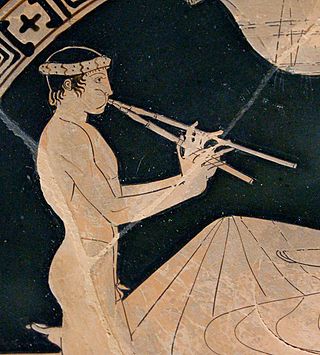
An aulos or tibia (Latin) was a wind instrument in ancient Greece, often depicted in art and also attested by archaeology.
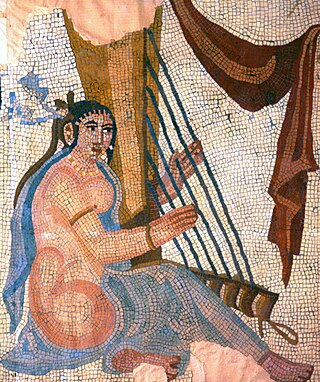
Ancient music refers to the musical cultures and practices that developed in the literate civilizations of the ancient world, succeeding the music of prehistoric societies and lasting until the Post-classical era. Major centers of ancient music developed in China, Egypt, Greece, India, Iran/Persia, the Maya civilization, Mesopotamia, and Rome. Though extremely diverse, the music of ancient civilizations is frequently characterized by monophony, improvisation, and the dominance of text in musical settings.
Mesomedes of Crete was a Greek citharode and lyric poet and composer of the early 2nd century AD in Roman Greece. Prior to the discovery of the Seikilos epitaph in the late 19th century, the hymns of Mesomedes were the only surviving written music from the ancient world. Three were published by Vincenzo Galilei in his Dialogo della musica antica e della moderna, during a period of intense investigation into music of the ancient Greeks. These hymns had been preserved through the Byzantine tradition(Anthol. pal. xiv. 63, xvi. 323), and were presented to Vincenzo by Girolamo Mei.
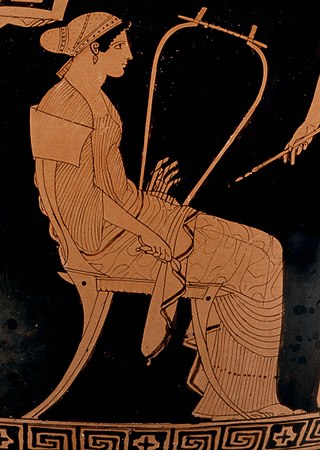
The barbiton, or barbitos, is an ancient stringed instrument related to the lyre known from Greek and Roman classics.
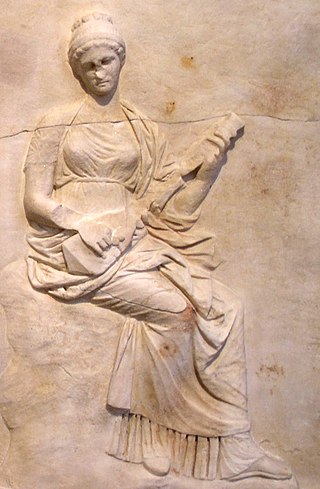
The pandura or pandore, an ancient string instrument, belonged in the broad class of the lute and guitar instruments. Akkadians played similar instruments from the 3rd millennium BC. Ancient Greek artwork depicts such lutes from the 3rd or 4th century BC onward. Iranian influences are indicated by the Persian origin of the word.

Music was almost universally present in ancient Greek society, from marriages, funerals, and religious ceremonies to theatre, folk music, and the ballad-like reciting of epic poetry. This played an integral role in the lives of ancient Greeks. There are some fragments of actual Greek musical notation, many literary references, depictions on ceramics and relevant archaeological remains, such that some things can be known—or reasonably surmised—about what the music sounded like, the general role of music in society, the economics of music, the importance of a professional caste of musicians, etc.

The music of ancient Rome was a part of Roman culture from the earliest of times. Songs (carmen) were an integral part of almost every social occasion. The Secular Ode of Horace, for instance, was commissioned by Augustus and performed by a mixed children's choir at the Secular Games in 17 BC. Music was customary at funerals, and the tibia, a woodwind instrument, was played at sacrifices to ward off ill influences. Under the influence of ancient Greek theory, music was thought to reflect the orderliness of the cosmos, and was associated particularly with mathematics and knowledge.

The kithara, Latinized as cithara, was an ancient Greek musical instrument in the yoke lutes family. It was a seven-stringed professional version of the lyre, which was regarded as a rustic, or folk instrument, appropriate for teaching music to beginners. As opposed to the simpler lyre, the cithara was primarily used by professional musicians, called kitharodes. In modern Greek, the word kithara has come to mean "guitar", a word which etymologically stems from kithara.

The Byzantine lyra or lira was a medieval bowed string musical instrument in the Byzantine Empire. In its popular form, the lyra was a pear-shaped instrument with three to five strings, held upright and played by stopping the strings from the side with the fingertips and fingernails. The oldest known depiction of the instrument is on a Byzantine ivory casket, dated to circa 900–1100 AD, preserved in the Bargello in Florence. Modern variants of the lyra are still played throughout the Balkans and in areas surrounding the Black Sea, including Greece, Crete, Karpathos, Albania, Montenegro, Serbia, Bulgaria, North Macedonia, Croatia, Italy, Turkey and Armenia.

Deductions about the music of the ancient Celts of the La Tène period and their Gallo-Roman and Romano-British descendants of Late Antiquity rely primarily on Greek and Roman sources, as well as on archaeological finds and interpretations including the reconstruction of the Celts' ancient instruments. Most of the textual information centers on military conflicts and on maybe the most prominent Celtic instrument of its time, the carnyx.
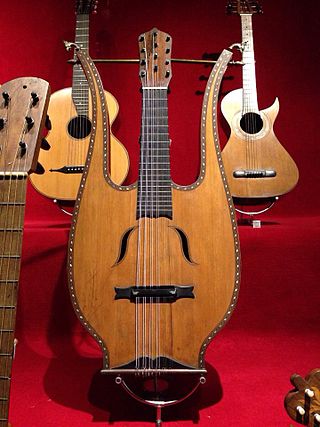
A musical instrument of the chordophone family, the lyre-guitar was a type of guitar shaped to look like a lyre, popular as a fad-instrument in the late 1800s. It had six single courses, with a fretboard located between two curved arms recalling the shape of the ancient Greek kithara. It was tuned and played like the conventional guitar.
Matteo Silva is a well known composer, music producer, ethnomusicologist and visual artist. He was born in Ulm, Germany from German mother and Italian father, grew up in Bologna, Italy and Lugano, Switzerland, studied composition at Giuseppe Verdi Conservatory in Milan with Niccolò Castiglioni and philosophy in Venice with Emanuele Severino; he is founder of the independent music record label Amiata Records; as radio editor he collaborated with Rete 2, a cultural channel of the Swiss Broadcasting Corporation and produced the “Encyclopedia of World Music” in 76 volumes for the Italian RCS Rizzoli Group published by Fabbri; for the group “Espresso – La Repubblica” he produced, among other series, a very popular CD series of “World Music”, a work that for the first time in Italy let music of less known cultures be accessible to a larger audience. Another remarkable project produced for the "Espresso - La Repubblica" group has been " La grande musica della Sardegna" a CD series on all different music styles in Sardinia approached in a musicological way but published for the first time outside the academic circuits with great public success.
Walter Maioli is an Italian researcher, paleorganologist, poly-instrumentalist and composer. Specialized in experimental archaeology and music, in particular that of archaic civilization. He has been researching the music of antiquity and prehistory for more than thirty-five years. Always interested in the music of the Mediterranean, he has gone on journeys to discover the folkloristic Italian and Mediterranean traditions learning the Arabic, African, Oriental, and European music since the beginning of the seventies.
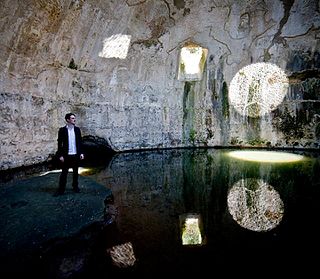
Corde Oblique are one of the main ethereal progressive neofolk bands from Italy. They are the solo project of Riccardo Prencipe with vocal contributions from numerous female singers and actresses. After seven albums the project began to change its skin and proposed "FolkGaze" sounds, a cross between folk and shoegazer.

A kollops is a tuning device for a string instrument which consists of a strip of leather wrapped around the instrument's crossbar, tightened by a wooden peg trapped in its wrap. The device is mentioned as early as the 7th century BC, used metaphorically in the Odyssey. The material itself, usually the hard material at the back of the neck of an ox, was known as "kollops" and thus the term was also used for the tuning device.

Music technology is the study or the use of any device, mechanism, machine or tool by a musician or composer to make or perform music; to compose, notate, playback or record songs or pieces; or to analyze or edit music.

Mechanical music technology is the use of any device, mechanism, machine or tool by a musician or composer to make or perform music; to compose, notate, play back or record songs or pieces; or to analyze or edit music. The earliest known applications of technology to music was prehistoric peoples' use of a tool to hand-drill holes in bones to make simple flutes. Ancient Egyptians developed stringed instruments, such as harps, lyres and lutes, which required making thin strings and some type of peg system for adjusting the pitch of the strings. Ancient Egyptians also used wind instruments such as double clarinets and percussion instruments such as cymbals. In Ancient Greece, instruments included the double-reed aulos and the lyre. Numerous instruments are referred to in the Bible, including the horn, pipe, lyre, harp, and bagpipe. During Biblical times, the cornet, flute, horn, organ, pipe, and trumpet were also used. During the Middle Ages, hand-written music notation was developed to write down the notes of religious Plainchant melodies; this notation enabled the Catholic church to disseminate the same chant melodies across its entire empire.
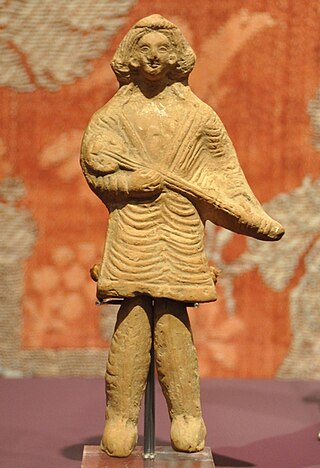
The Parthian Empire, a major state of ancient Iran, lasted from 247 BCE to 224 CE, in which music played a prominent role. It featured in festivals, weddings, education, warfare and other social gatherings. Surviving artistic records indicate that it involved both men and women, who could be instrumentalists or singers. Along with the older music of the previous Medians, Assyrians and particularly the Achaemenid period, Parthian music was crucial in laying the foundation for the golden age of subsequent Sasanian music.

The psalterion is a stringed, plucked instrument, an ancient Greek harp. Psalterion was a general word for harps in the latter part of the 4th century B.C. It meant "plucking instrument".




















